As fiber-to-the-home (FTTH) network technology rapidly advances, GPON (Gigabit Passive Optical Network) has become the standard choice for most operators worldwide. However, with increasing demands for higher bandwidth, symmetrical rates, and lower latency, XGSPON (10G Symmetric Passive Optical Network) is gaining attention as the next-generation fiber access technology. In this context, Combo PON technology has emerged, efficiently integrating GPON and XGSPON network technologies, helping operators meet current needs while smoothly transitioning to higher-performance networks.
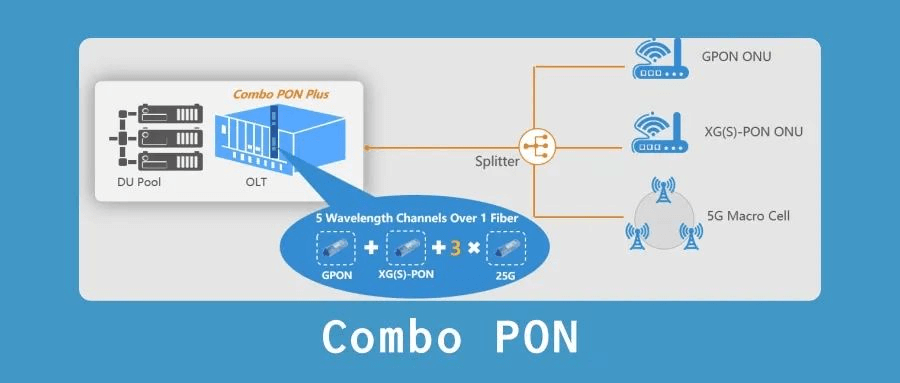
Overview of Combo PON Technology
Combo PON is a solution that integrates GPON and XGSPON network technologies, supporting both on the same optical distribution network (ODN). Traditional GPON technology offers a downstream bandwidth of 2.5Gbps and an upstream bandwidth of 1.25Gbps, while XGSPON can provide symmetrical 10Gbps rates. The core advantage of Combo PON is its ability to transmit these two technologies over the same optical fiber without requiring additional coexistence modules, greatly simplifying network structure.
Working Principle of Combo PON
Combo PON supports both GPON and XGSPON MAC layers simultaneously at the Optical Line Terminal (OLT) port. It uses an optical combiner to merge the signals of both technologies onto the same optical fiber. This means that new deployments and existing GPON networks can run both technologies simultaneously through a single Combo PON module without extra wavelength coexistence modules.
In practical operation, GPON and XGSPON signals transmitted through the optical distribution network are received and processed by different Optical Network Units (ONUs). GPON ONUs can only receive and process GPON signals, while XGSPON ONUs handle higher bandwidth XGSPON signals. In this way, Combo PON enables multi-rate coexistence on the same physical infrastructure without affecting the user experience.
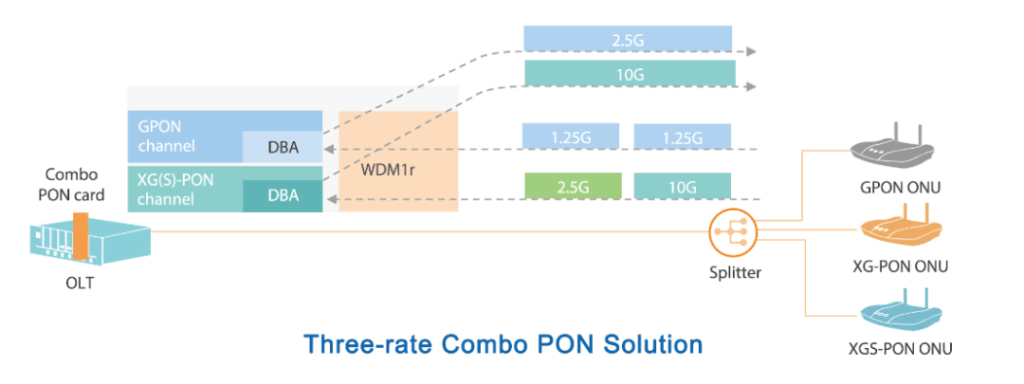
Differences Between Combo PON, GPON, and XG-PON
1. Transmission Rates
- GPON: Provides downstream rates of 2.5 Gbps and upstream rates of 1.25 Gbps.
- XG-PON: Significantly increases transmission rates with 10 Gbps downstream and 2.5 Gbps upstream.
- Combo PON: Integrates GPON and XG-PON technologies, supporting both rates simultaneously. It can offer GPON’s 2.5 Gbps/1.25 Gbps and XG-PON’s 10 Gbps/2.5 Gbps.
2. Wavelength Utilization
- GPON: Uses 1310nm for upstream and 1490nm for downstream wavelengths.
- XG-PON: Uses 1270nm for upstream and 1577nm for downstream wavelengths.
- Combo PON: Utilizes built-in WDM (Wavelength Division Multiplexing) devices to enable single fiber four-wavelength transmission, supporting the independent sending and receiving of GPON and XG-PON signals on the same fiber.

3. Compatibility
- GPON: As an earlier technology, GPON is widely adopted globally, with mature equipment and technology.
- XG-PON: An upgrade from GPON, XG-PON can coexist with existing GPON networks, supporting a smooth transition.
- Combo PON: By integrating GPON and XG-PON technologies, Combo PON is compatible with existing GPON networks while providing high-bandwidth services, facilitating a smooth network upgrade.
4. Cost
- GPON: Due to its maturity, GPON equipment costs are relatively low, making it suitable for large-scale deployments.
- XG-PON: Although XG-PON equipment is more expensive, its high bandwidth and performance offer significant advantages for future network upgrades.
- Combo PON: Combo PON equipment is costlier, but it reduces overall upgrade costs by being compatible with existing networks while providing high-bandwidth services.
5. Application Scenarios
- GPON: Primarily used for residential broadband access, IP telephony, and digital TV services.
- XG-PON: Suitable for higher bandwidth scenarios, such as enterprise networks, data center interconnects, and high-bandwidth residential users.
- Combo PON: Ideal for scenarios requiring compatibility with existing GPON networks and high-bandwidth services, particularly suitable for operators upgrading their networks.
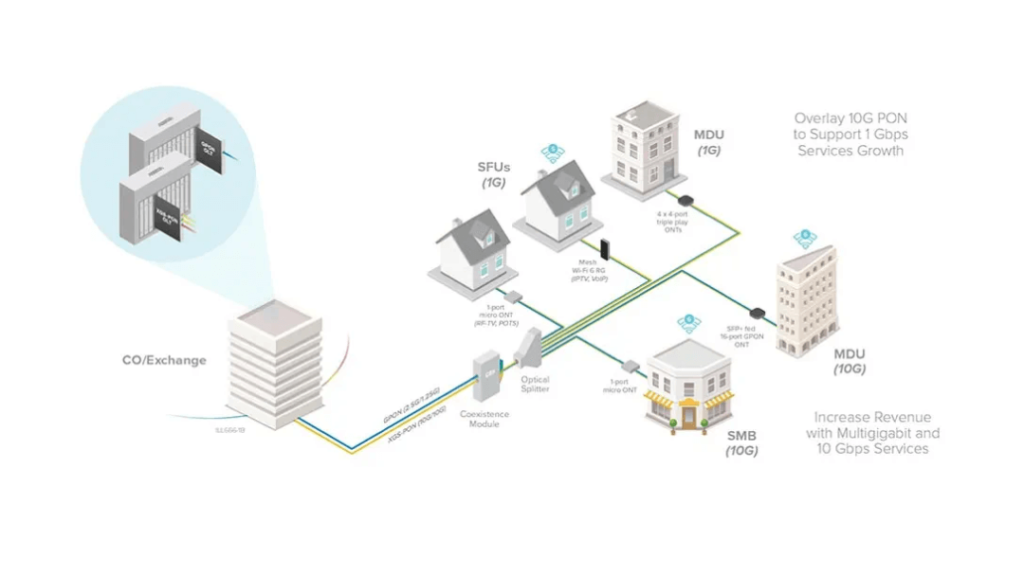
The first generation of XGSPON technology required additional external coexistence modules (CEx modules) to combine GPON and XGSPON signals on the same fiber. In contrast, Combo PON eliminates the need for these external devices, simplifying deployment and reducing optical power loss. Additionally, Combo PON can support the MAC processing of both GPON and XGSPON through a single OLT port, greatly enhancing network integration and scalability.
Economic Benefits of Combo PON
Combo PON technology not only achieves efficient integration of GPON and XGSPON at a technical level but also brings significant cost benefits to operators. By reducing the number of devices, lowering energy consumption, and minimizing capital expenditures, Combo PON provides a cost-effective solution for network operators.
Cost Efficiency
Traditional GPON and XGSPON hybrid network architectures typically require separate OLT systems and external coexistence modules, increasing equipment costs and space requirements for operators. In contrast, Combo PON integrates GPON and XGSPON within a single OLT module, significantly reducing equipment space and power consumption.
According to research by Adtran, upgrading an existing GPON network with 20,000 users to XGSPON using Combo PON can help service providers reduce rack space by up to 75%, lower power consumption by 66%, and cut capital expenditures by 50%. For operators building new or upgrading existing GPON networks, Combo PON can significantly reduce the total cost of network construction.
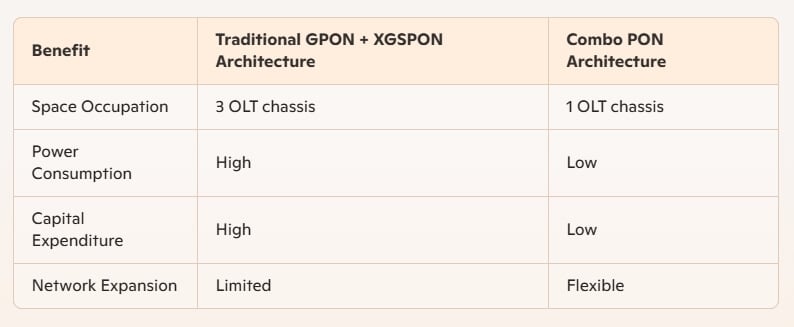
Energy Efficiency
By reducing the number of required OLT devices, Combo PON not only reduces physical space occupation but also significantly lowers power consumption. Fewer operating devices mean lower cooling needs, further reducing data center operational costs and carbon emissions. Additionally, Combo PON eliminates the optical power loss introduced by external coexistence modules, enabling operators to leverage higher optical power budgets to cover wider service areas and enhance network service capabilities.
Reduced Capital Expenditure
Integrating GPON and XGSPON technology, Combo PON eliminates the need for operators to deploy two separate OLT systems. This reduction in equipment procurement costs simplifies network operation and maintenance, lowering long-term operational expenses. Furthermore, Combo PON supports the automatic inheritance of existing GPON service configurations, avoiding repeated configuration and user interference, further reducing the operational burden on operators.
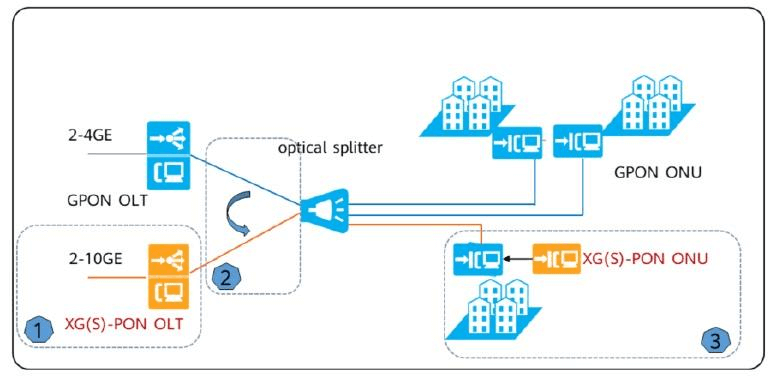
Combo PON technology thus provides a comprehensive solution that optimizes both technical and economic aspects for network operators, facilitating smoother transitions and upgrades to higher performance networks.
Application Scenarios for Combo PON
Due to its combination of technical and economic benefits, Combo PON performs exceptionally well in various application scenarios, particularly in new network deployments, existing network upgrades, and high-bandwidth service scenarios.
1. New FTTH Networks
In new fiber-to-the-home (FTTH) network deployments, Combo PON offers operators greater flexibility. Operators can initially deploy GPON to provide entry-level services such as 100Mbps broadband and later upgrade to XGSPON to offer 10Gbps high-speed services as user demands increase. This flexibility enhances the network’s long-term scalability while saving on initial network construction costs.
2. Upgrading Existing GPON Networks
For operators with existing GPON networks, Combo PON provides a smooth upgrade path. By introducing XGSPON technology into the current GPON network, operators can offer higher bandwidth services without altering the ODN (Optical Distribution Network) structure. This upgrade process does not require additional home visits or user device replacements, significantly reducing the complexity and cost of network upgrades.
3. Enterprise and Residential Broadband Services
Combo PON also excels in supporting multi-service integration. Operators can use GPON to provide 100Mbps broadband services to residential users, while using XGSPON to deliver higher bandwidth, lower latency dedicated services to enterprise customers. This capability to support multiple services concurrently enhances operators’ business flexibility and market competitiveness.
4. Smart City and IoT Applications
In smart city and Internet of Things (IoT) applications, Combo PON supports the connection and real-time data transmission of numerous smart devices with its high bandwidth and low latency features. Operators can leverage Combo PON to provide efficient, stable network support without changing existing infrastructure, meeting the needs of various smart applications.
Conclusion
Combo PON integrates two generations of PON technology (e.g., GPON and XG-PON) into a single board and optical module, achieving compatibility between the two. By combining different wavelength signals within a single optical module, Combo PON can simultaneously support independent transmission and reception of GPON and 10G PON signals. This not only ensures compatibility with existing GPON networks but also provides high-bandwidth services as needed, facilitating smooth network upgrades.
Using different carrier wavelengths, Combo PON combines two wavelengths within one optical module to achieve independent transmission and reception of GPON and 10G PON signals. Specifically, GPON uses 1310nm for upstream and 1490nm for downstream, while XG-PON uses 1270nm for upstream and 1577nm for downstream. With built-in WDM (Wavelength Division Multiplexing) devices, Combo PON enables single-fiber four-wavelength transmission.
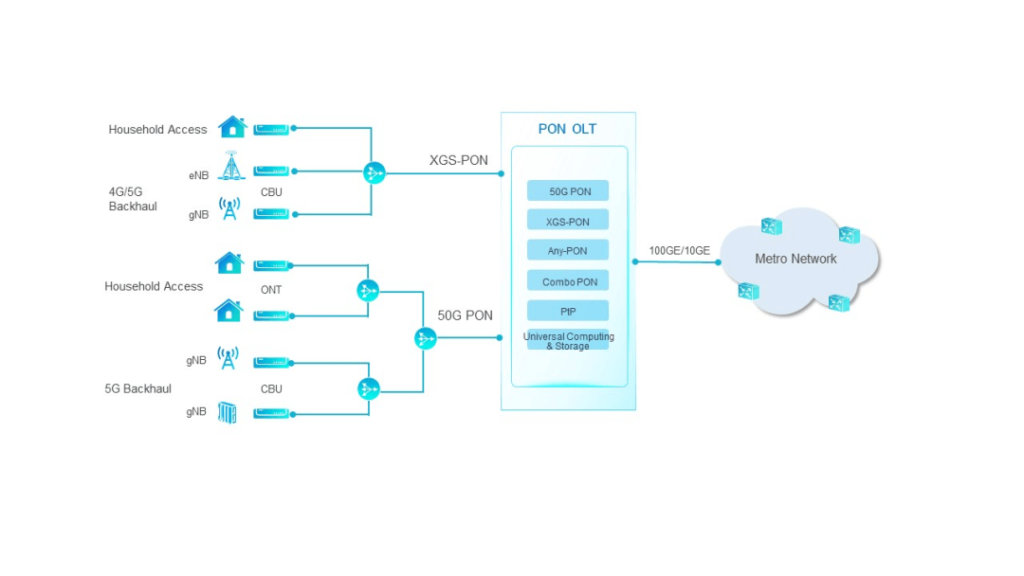
Combo PON has undergone technical verification and commercial trials in multiple operator networks. For example, ZTE’s Combo PON solution has been successfully applied in China Telecom and China Unicom’s networks. This solution not only improves bandwidth utilization but also reduces investment costs and the difficulty of engineering modifications for operators.
Table of Contents
ToggleRelated Products:
-
 XGSPON-ONU-C XGSPON ONU SFP+ TX-9.95G/RX-9.95G TX-1270nm/RX-1577nm N1/N2 SC DDM 0°C~70°C Optical Transceivers
$75.00
XGSPON-ONU-C XGSPON ONU SFP+ TX-9.95G/RX-9.95G TX-1270nm/RX-1577nm N1/N2 SC DDM 0°C~70°C Optical Transceivers
$75.00
-
 FiberMall XGS/GPON-OLT-CB+ XGSPON GPON Combo B+ OLT MPM SFP-DD TX-9.95G/RX 9.953G, 2.488 Gbps Tx-1577nm/Rx-1270nm SC UPC DDM Optical Transceivers
$300.00
FiberMall XGS/GPON-OLT-CB+ XGSPON GPON Combo B+ OLT MPM SFP-DD TX-9.95G/RX 9.953G, 2.488 Gbps Tx-1577nm/Rx-1270nm SC UPC DDM Optical Transceivers
$300.00
-
 FiberMall XGSPON-OLT-SN1 XGSPON OLT SFP+ TX-9.95G/RX-9.95G, 2.488G Tx-1577nm/Rx-1270nm SN1 SC UPC DDM Optical Transceivers
$300.00
FiberMall XGSPON-OLT-SN1 XGSPON OLT SFP+ TX-9.95G/RX-9.95G, 2.488G Tx-1577nm/Rx-1270nm SN1 SC UPC DDM Optical Transceivers
$300.00
-
 FiberMall XGS/GPON-OLT-CC+ XGSPON GPON Combo C+ OLT MPM SFP+ TX-9.95G/RX 9.953G, 2.488 Gbps Tx-1577nm/Rx-1270nm SC UPC DDM Optical Transceivers
$315.00
FiberMall XGS/GPON-OLT-CC+ XGSPON GPON Combo C+ OLT MPM SFP+ TX-9.95G/RX 9.953G, 2.488 Gbps Tx-1577nm/Rx-1270nm SC UPC DDM Optical Transceivers
$315.00
-
 FiberMall XGS/GPON-OLT-IB+ XGSPON GPON Combo B+ I-temp OLT MPM SFP-DD TX-9.95G/RX-9.95G Tx-1577nm/Rx-1270nm SC DDM -40°C~85°C Optical Transceivers
$315.00
FiberMall XGS/GPON-OLT-IB+ XGSPON GPON Combo B+ I-temp OLT MPM SFP-DD TX-9.95G/RX-9.95G Tx-1577nm/Rx-1270nm SC DDM -40°C~85°C Optical Transceivers
$315.00
-
 FiberMall XGSPON-OLT-SN2 XGSPON OLT SFP+ TX-9.95G/RX-9.95G, 2.488G Tx-1577nm/Rx-1270nm SN2 SC UPC DDM Optical Transceivers
$315.00
FiberMall XGSPON-OLT-SN2 XGSPON OLT SFP+ TX-9.95G/RX-9.95G, 2.488G Tx-1577nm/Rx-1270nm SN2 SC UPC DDM Optical Transceivers
$315.00
-
 FiberMall XGS/GPON-OLT-SBC XGSPON GPON Combo B+ OLT MPM SFP+ TX-9.95G/RX 9.953G, 2.488 Gbps Tx-1577nm/Rx-1270nm SC UPC DDM Optical Transceivers
$325.00
FiberMall XGS/GPON-OLT-SBC XGSPON GPON Combo B+ OLT MPM SFP+ TX-9.95G/RX 9.953G, 2.488 Gbps Tx-1577nm/Rx-1270nm SC UPC DDM Optical Transceivers
$325.00
-
 FiberMall XGS/GPON-OLT-IC+ XGSPON GPON Combo C+ I-temp OLT MPM SFP-DD TX-9.95G/RX-9.95G Tx-1577nm/Rx-1270nm SC DDM Optical Transceivers
$330.00
FiberMall XGS/GPON-OLT-IC+ XGSPON GPON Combo C+ I-temp OLT MPM SFP-DD TX-9.95G/RX-9.95G Tx-1577nm/Rx-1270nm SC DDM Optical Transceivers
$330.00
-
 FiberMall XGS/GPON-OLT-SCC XGSPON GPON Combo C+ OLT MPM SFP+ TX-9.95G/RX 9.953G, 2.488 Gbps Tx-1577nm/Rx-1270nm SC UPC DDM Optical Transceivers
$345.00
FiberMall XGS/GPON-OLT-SCC XGSPON GPON Combo C+ OLT MPM SFP+ TX-9.95G/RX 9.953G, 2.488 Gbps Tx-1577nm/Rx-1270nm SC UPC DDM Optical Transceivers
$345.00
-
 FiberMall XGS/GPON-OLT-SBI XGSPON GPON Combo B+ I-temp OLT MPM SFP+ TX-9.95G/RX 9.953G, 2.488 Gbps Tx-1577nm/Rx-1270nm SC UPC DDM Optical Transceivers
$345.00
FiberMall XGS/GPON-OLT-SBI XGSPON GPON Combo B+ I-temp OLT MPM SFP+ TX-9.95G/RX 9.953G, 2.488 Gbps Tx-1577nm/Rx-1270nm SC UPC DDM Optical Transceivers
$345.00
-
 FiberMall XGSPON-OLT-SIN1 XGSPON OLT SFP+ TX-9.95G/RX-9.95G, 2.488G Tx-1577nm/Rx-1270nm SN1 SC UPC DDM Industrial Optical Transceivers
$360.00
FiberMall XGSPON-OLT-SIN1 XGSPON OLT SFP+ TX-9.95G/RX-9.95G, 2.488G Tx-1577nm/Rx-1270nm SN1 SC UPC DDM Industrial Optical Transceivers
$360.00
-
 FiberMall XGS/GPON-OLT-SCI XGSPON GPON Combo C+ I-temp OLT MPM SFP+ TX-9.95G/RX 9.953G, 2.488 Gbps Tx-1577nm/Rx-1270nm SC UPC DDM Optical Transceivers
$365.00
FiberMall XGS/GPON-OLT-SCI XGSPON GPON Combo C+ I-temp OLT MPM SFP+ TX-9.95G/RX 9.953G, 2.488 Gbps Tx-1577nm/Rx-1270nm SC UPC DDM Optical Transceivers
$365.00
-
 FiberMall XGSPON-OLT-SIN2 XGSPON OLT SFP+ TX-9.95G/RX-9.95G, 2.488G Tx-1577nm/Rx-1270nm SN2 SC UPC DDM Industrial Optical Transceivers
$380.00
FiberMall XGSPON-OLT-SIN2 XGSPON OLT SFP+ TX-9.95G/RX-9.95G, 2.488G Tx-1577nm/Rx-1270nm SN2 SC UPC DDM Industrial Optical Transceivers
$380.00
-
 FiberMall XGS/GPON-OLT-SDC XGSPON GPON Combo D OLT MPM SFP+ TX-9.95G/RX 9.953G, 2.488 Gbps Tx-1577nm/Rx-1270nm SC UPC DDM Optical Transceivers
$465.00
FiberMall XGS/GPON-OLT-SDC XGSPON GPON Combo D OLT MPM SFP+ TX-9.95G/RX 9.953G, 2.488 Gbps Tx-1577nm/Rx-1270nm SC UPC DDM Optical Transceivers
$465.00
-
 FiberMall XGS/GPON-OLT-SDI XGSPON GPON Combo D I-temp OLT MPM SFP+ TX-9.95G/RX 9.953G, 2.488 Gbps Tx-1577nm/Rx-1270nm SC UPC DDM Optical Transceivers
$515.00
FiberMall XGS/GPON-OLT-SDI XGSPON GPON Combo D I-temp OLT MPM SFP+ TX-9.95G/RX 9.953G, 2.488 Gbps Tx-1577nm/Rx-1270nm SC UPC DDM Optical Transceivers
$515.00















